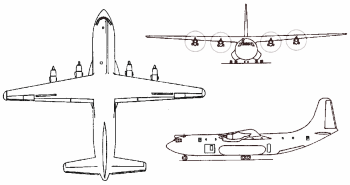



Despite a very limited production run which resulted in just ten examples, the Short Belfast has the distinction of being the British-designed RAF transport with the heaviest payload ever built. It was designed to handle heavy freight such as artillery pieces, vehicles (including a single Chieftain tank), guided missiles, and helicopters which were loaded via 'beaver tail' rear loading doors and ramp; it could also carry up to 150 troops and was optimized for long range operations overseas. Nevertheless, its cargo capacity was inferior to other comtemporary designs such as the Soviet An-22 whose take-off weight was more than twice the Belfast's. Eventually, the Belfast entered service with the RAF's No. 53 Squadron where they flew for approximately a decade before being re-adopted for commercial use. Some civil units were also hurriedly pressed for military duty during the Falklands War at considerable cost.
The four-engined SC.5/10 first flew on 5 January 1964, entering service with the RAF as the Belfast C.1. No other variants were built given its small production but it is interesting to note that each aircraft was given an individual name based on various Greek mythological figures.
Preceded by:
NoneSucceeded by:
None | |
| Design | Belfast C.1 |
| Type | Transport |
| Year | 1966 |
| Crew | 4-6 |
| Dimensions | |
| Length | 41.58 m |
| Height | 14.326 m |
| Wing Span | 48.41 m |
| Wing Area | n/a |
| Weight | |
| Empty | 57,607 kg |
| Maximum | 100,000 kg |
| Wing Loading | 436.5 kg/m² |
| Performance | |
| Speed | 566 km/h |
| Ceiling | 9,144 m |
| Range | 8,529 km |
| Powerplant | |
| Engine | 4 x Tyne Mk. 101 Rolls-Royce 4,273 kW |
| Thrust/Weight | 0.36 |
| Armament | |
| Guns | - |
| Payload | 35,381 kg |
| Production | |
| Built | 10 |
| Total | 10 |